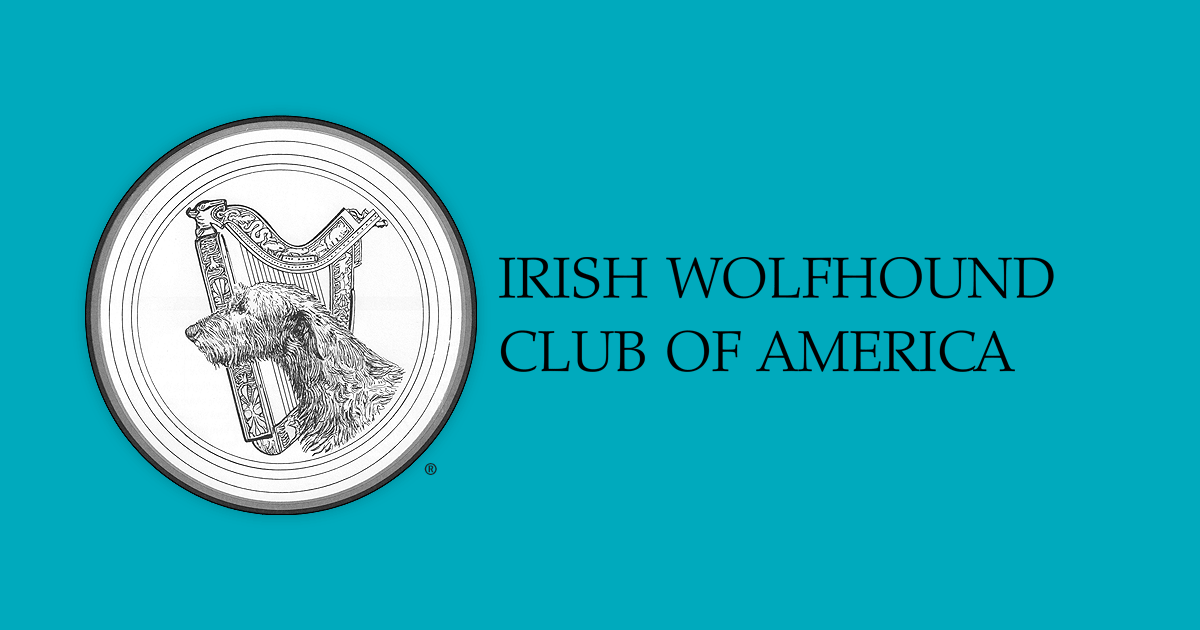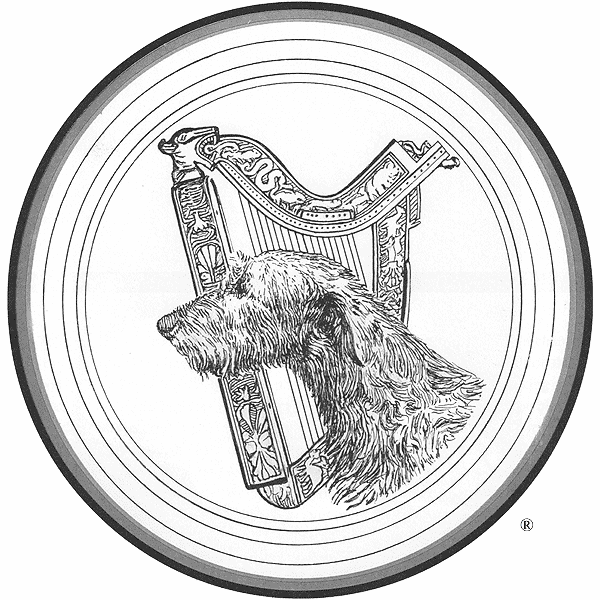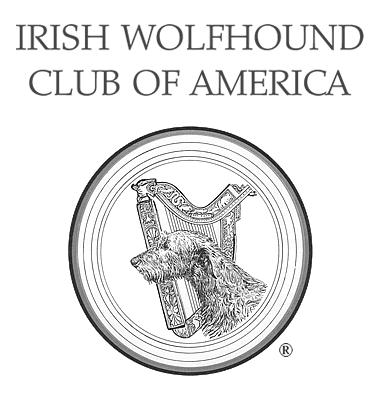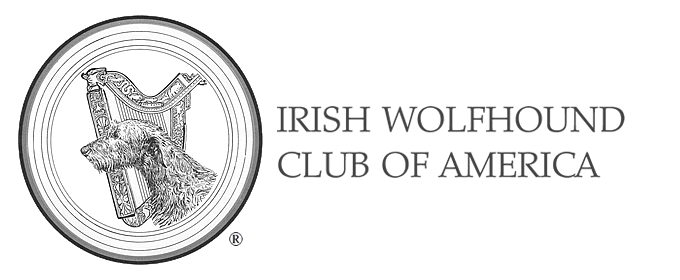Judging Irish Wolfhounds - A Guide
Published and Distributed by The Irish Wolfhound Club of America, Inc.
© Joel Samaha. Illustrations by Beverly Stobart and Robert Bernardi.
Introduction
Joel Samaha, remarks before judging the 1985 IWCA National Specialty
A National Specialty brings together many dogs from all over the country and even from other countries. It affords a rare opportunity to see dogs across a wide spectrum who in their owners' judgment represent the best they have. Viewed from a broad perspective, these dogs enable us to assess our breed's past, present and future. Dogs in their prime - concentrated in the Bred By Exhibitor, American Bred, Open and Specials classes - represent the breed's present state. Also in evidence is our deep debt to the past. We glimpse that past in the Veterans classes first hand and it speaks to us indirectly through the heritage displayed in pedigrees from all classes. We must never forget this heritage in our preoccupation with the present. Not only do we see the present and the past, in the puppies, yearlings and novices is revealed our hope for the breed's future. They are a gauge to the direction we are going. From them, we can assess to what extent we are fulfilling our custodial responsibility to leave the breed in at least as good condition as we found it. Attending a Specialty, then, is obviously a valuable opportunity to learn about our breed. But it can be overwhelming, especially to novices who wonder how best to reap the benefits from this experience. In order to help you follow the judging, I have outlined my procedure for deciding where to place the dogs in each class. I have also included some comments about each step. I hope they will give you a little idea what I am doing and why. Use this guide and commentary not only to follow what I am doing but also to clarify your own ideas. I believe firmly, and urge you strongly, to make your own decisions about the dogs. Everyone has an opinion. We all like some dogs more than others and have a "favorite" dog at the show. Don't be afraid to take a stand. Compare your decision with mine and consider why you prefer some to others and why one is your choice for Best In Show.
Preliminary Considerations
- Absolute rights and wrongs do not exist. The Irish Wolfhound Standard defines a range, not a point, on a spectrum of correct type. Reasonable people can and do disagree about the meaning of the Irish Wolfhound Standard. Even if they agree on the general provisions in the Standard, they argue about how to apply the Standard to particular dogs. Don't let this confuse and discourage you. Honest disagreement renders the whole experience interesting, exciting, challenging, and immensely pleasurable. Except for direct experience with the hounds themselves, some of my best Irish Wolfhound memories include those of heated discussions about the meaning of the rough-coated Greyhound-like dog of great size and commanding appearance that typifies our breed. These arguments immeasurably enhanced my understanding of true breed type. Inform your judgment, but in the end remember, it is your day to pick the dogs that fall within the range the Standard defines.
- Simple answers to questions about Irish Wolfhounds do not exist. Some people believe a simple, straightforward, single formula exists for judging, showing, breeding, feeding, rearing, and living with Irish Wolfhounds. Anyone who believes this is simple-minded. Unfortunately, we do not yet know many things; others we will probably never know. To complicate matters further, out knowledge may greatly benefit one dog while wreaking havoc on another. To most questions about Irish Wolfhounds we can only answer unsatisfyingly, "We don't know." "It might be A, but it could be B or C or even A, B, C and X!" No one likes such vague answers to questions we want answered so desperately. But that does not make the answers wrong.
- Keep an open mind. Recognize that other judges have reasonable points of view. A different point of view is not always wrong. On the one hand, judges who place dogs in a somewhat different order within an acceptable range are not necessarily either stupid or ignorant. On the other hand, placing the dogs in exactly the order you would have placed them does not automatically render these judges brilliant and knowledgeable. Try to understand why others might honestly disagree with you and look for the merit in their decisions and opinions.
- Judging requires finding dogs who approximate an ideal. No dog is perfect; no living creature is. Judging, therefore, must always compromise reality and an ideal. In the end, you must choose the best dogs in real life, not the non-existent perfect one in your mind's eye. The dogs in living flesh which come closest to your mind's eye picture of the perfect dog deserve the prizes.
The following represents but one of several acceptable approaches to judging Irish Wolfhounds. Experienced judges may wish immediately to alter it to suit their personal style and procedure. New judges should find it useful as a start that they might modify as their experience develops. However, all judges should follow its general ideas in order to find the dogs that best conform to the Irish Wolfhound Standard.
Overall Impression
Gain an overall impression of the dogs as a group at the outset. Most people may think that this includes only an impression of the dogs as they stand in a line. I believe it also encompasses the impression that they create in motion. Hence, I recommend that you gain your overall impression by observing the dogs both standing and in motion.
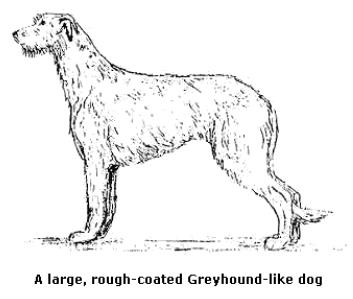
1. Standing. At the start of every class, look up and down the line of dogs in order to assess four critical features:
Shape or outline. Looking at the row of dogs creates your first opportunity to determine which dogs fit the image of the large, rough-coated Greyhound-like dog the Standard calls for. Look for the curves, depth of chest, length of neck, body and leg that combine to produce an outline or silhouette of a large, strong, galloping hound. Remember, the Standard requires first and foremost a large, rough-coated Greyhound-like dog. Reward it highly when you see it; avoid awarding ribbons to those who do not possess it.
Presence. Don't confuse presence with quality. A dog with presence bears itself as if to say, "I am the one!" This dog does not plead for recognition. It knows it is best and hopes you agree. If you don't, it's your loss. This dog has "commanding appearance". Remember that the Standard demands not only great size but commanding appearance. Equally important, don't mistake the dog with its head held highest in the air for the one with the most presence. In many cases the head held high may reveal presence. However, it can also reveal a serious fault" the column front. Dogs with this fault, often seen in conjunction with ewe necks, may impress the novice, but their strained, uncomfortable stance and movement belies the more relaxed proud bearing of the Irish Wolfhound with true presence.
Quality. An experienced judge said she could not define quality; it speaks for itself. And so it does. Dogs who possess it stand away from the others, as if they were cast in a special mold. Look for quality and reward it.
Balance. Lack of balance greatly diminishes shape, presence, and quality. All the parts of a balanced Irish Wolfhound fit together. Curves and length, breadth and depth, substance and shape hang together. A balanced dog rests there, just as the word balance implies. Unbalanced dogs make you feel awkward; even the most skillful handlers cannot bend them into balance, even though they cleverly try. Some examples of imbalance include: a long body on short legs; a very steep shoulder and curving stifles; a short neck set into a long body; longs legs and shallow chest. A dog may possess balance and lack correct type. A dog with a short neck, short body, straight shoulders, and straight stifles has balance; it lacks correct type.
2. In Motion. After you gain an initial impression from the dogs standing still, ask their handlers to take them around the ring all together. At this time do not assess sound movement. That will come later when you examine individual dogs. At this point look for shape, presence, quality, and balance in motion. This step will frequently surprise you. The dogs who look best standing still may not remain so in motion. The straight dog's shape standing can in motion suddenly transform into all the right soft curves. The balanced hound standing can in motion look as if many parts from different dogs were all stuck together in one animal.
Many judges omit this critical step of assessing shape, presence, quality, and balance in motion. Yet, experience will demonstrate to you that dogs standing change substantially when in motion. This occurs not simply because motion uncovers unsound movement but in addition because it exposes faults in type. You will find it difficult to choose between the dog who possesses shape, quality, presence, and balance standing but loses them in motion and one who possesses them in motion but not standing. The best hounds, of course, excel in both.
Judging Individual Dogs
Judges differ in the extent to which they rely on two critical elements in judging individual dogs: (1) looking at the dog and (2) feeling, or "getting your hands on the dog". What should you be looking and feeling for? Only by looking and touching can you ascertain five basic characteristics of Irish Wolfhounds:
1. Substance. Proper substance means the dog has sufficient bone, muscle, breadth and depth. Think always of two characteristics of substance: (1) power and (2) speed.
Irish Wolfhounds must LOOK strong; they must also BE strong. Typical Irish Wolfhounds are never weak or refined, nor should they even appear to be either. They ought to resemble hunters more than racers.
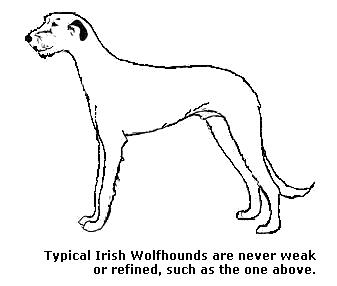
The essence of Irish Wolfhound type lies in the balance between power and speed that produces a dog fast enough to catch a wolf and, once caught, strong enough to kill it.
Put your hand around a dog's forearm at the elbow and run it down through the pastern. You should feel thick bone covered with plenty of hard muscle. Your hand, if it is good-sized, should only just reach around the foreleg immediately above the dog's wrist. The legs should have shape, somewhat broader near the elbow than at the pastern. They should not curve too much, particularly they should not twist. However, forelegs should not resemble tubes or Coke cans; that is, they should not appear round without any curve.
Feel the rib cage to determine both the breadth and the depth of chest. Think of an egg shape or oval when feeling the chest. Avoid rewarding dogs with either barrel chests or slab sides.
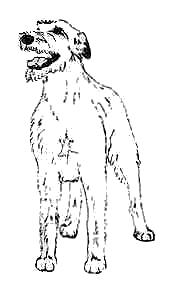
Take special care to look over and feel the hindquarters. The croup should neither fall steeply away nor run flat to the base of the tail. It should gently slope to the dog's tail. Judges frequently overlook the importance of the croup. Learn to identify the properly sloped croup. It contributes to the galloping hound look; it enhances the dog's movement. Make sure that you assess the amount and quality of critical muscle in both thigh and second thigh. (See below for more detail on these points.)
Some dogs have too much bone and muscle - they are what we call coarse. Hence they, like the refined "deerhoundy" dogs, lack correct type. However, coarseness is not a breed problem. Indiscriminate breeding leads to refinement, not coarseness in succeeding generations. Dogs with too much substance occur sometimes; refinement appears too often. It is much easier to correct coarseness than refinement in breeding. Therefore, if in doubt prefer a dog with too much substance rather than one with too little.
NOTE WELL: Never take this necessary preference for coarseness over refinement
to mean that the biggest dogs with the most bone and muscle should always win. Substance must be reckoned in concert with all other important breed characteristics! Think always of the balance between speed and strength.
2. Structure. Assessing structure requires you to determine whether the dog is properly put together. Dogs with the proper structure feel both good and right; your hands should not encounter improperly placed lumps and bumps of bone and muscle as they move down and over a dog's body. Instead, they ought to glide smoothly from the head over the neck through the shoulders, over the back, to the croup and hindquarters. Evaluating structure also requires specifically examining with eyes and hands:
Head - In order to judge heads completely, you must take into account its overall shape, and then more particularly the eyes, mouth, teeth and jaws, ears, whiskers. We do not want either too refined, narrow heads that resemble too much either the Deerhound on one extreme, or the chiseled Dane head or the broad, thick, short-muzzled Mastiff head with drooping ears at the other. We should see a Greyhound-like head but stronger, a bit thicker, and proportionately larger to suit the Irish Wolfhound's stronger, larger body. Face furnishings, particularly whiskers, ordinarily enhance a dog's head; they can also conceal weak and exaggerate strong heads. Furthermore, they can soften the undesirable hard expression in some Irish Wolfhounds. The proper Irish Wolfhound head, combined with a dignified, soft, almost sad, far-off look contributes substantially to correct type. Don't overrate it, but give it its due. Unfortunately, you will often find unattractively plain or improper heads on dogs that otherwise excel in type. The reverse is also true: beautiful heads filled with type appear on dogs lacking in other respects. As in life generally, don't allow the beautiful face to mar your judgment.
Front Assembly - the neck, shoulder, upper arm, foreleg, pastern and feet. Relatively long, powerful, arched necks should set into shoulders laid well back that slope inward at the withers. Some say you should find no more than three-fingers width between the withers. Penalize: hounds with short necks set on too far to the front, stuffed into loaded upright shoulders and short upper arms; hounds with narrow, weak giraffe-like necks set on too high; and the ewe-necked hounds that stand with heads uncomfortably high and necks that break abruptly into the shoulder.
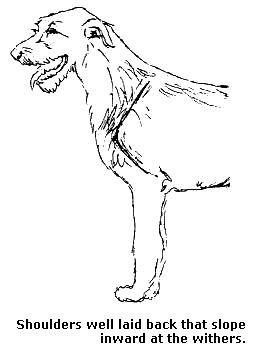
Upper arms should balance the shoulder in length and angle; they ought also to balance length and angle of the thigh and stifle. You should penalize Irish Wolfhounds with straight, short upper arms, a fault much too prevalent today. Look for, and reward, shapely, strong forearms, and round, strong, tight feet. Look for well-filled forechests; hollow, narrow forechests revealed in front legs that do not allow you to get a hand comfortably between them is a serious fault.
Overall, consider the column front, or a line that runs straight down from the base of the skull, through the withers, shoulder, upper arm, forearm, and pastern a fault of the most serious kind in Irish Wolfhounds.
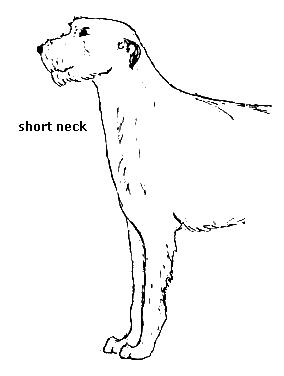
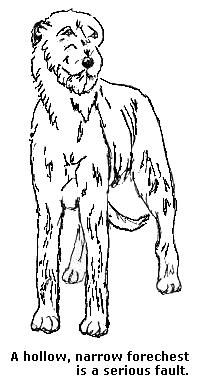
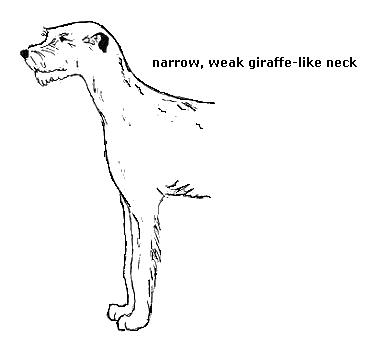
Body - The proper Irish Wolfhound body contains a chest with both depth and spring of rib, and a back rather long than short, with sufficient muscle throughout and a topline slightly arched over the loin. Both roached backs, fortunately not frequently seen, and flat backs, unhappily more prevalent, are incorrect. Flat toplines deserve special attention, not only because they appear more frequently but also because they seriously detract from the coiled mechanism necessary for efficient galloping. Flat toplines may please the inexperienced; the judge of Irish Wolfhounds must recognize and heavily penalize the flat back. Even worse, penalize the flat, sloping back that makes Irish Wolfhounds resemble giant sporting dogs.
The Irish Wolfhound's underline should reveal a long brisket with good tuck-up; however, no wasp-waists, please. Look for dogs well-ribbed back; ideally, the space from the last rib to the front of the stifle should not contain more than roughly four slightly spread fingers.
Rear Assembly - croup, thighs, second thighs, hocks and feet. The proper Irish Wolfhound croup slopes slightly; penalize both flat and steep croups, both of which detract from proper Irish Wolfhound type and which indicate weakness in the power and speed of movement. Heavy muscle should cover both thighs and second thighs, the latter too often not given sufficient weight. Looking at the dog from the rear, its assembly and musculature should resemble the working Greyhound, like that pictured in the great Victorian authority Stonehenge's book, not like those sad specimens too often seen in the conformation ring today. Stifles should bend nicely; not nearly so much as the German Shepherd, however, not should they be straight, the latter a more prevalent and more serious fault. Look for strength, substance, and shape throughout the rear assembly. Penalize the hound with heavily boned and muscled thighs followed by spindly, weak second thighs without adequate muscle to balance the thighs above.
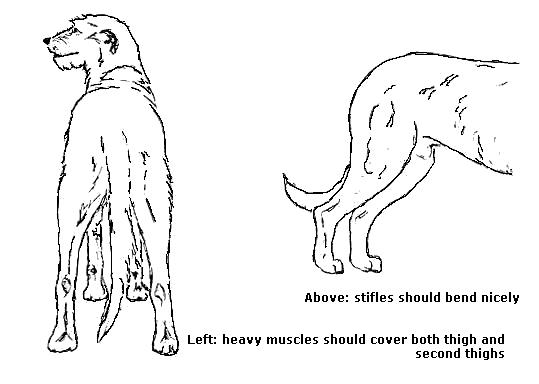
Tail - Be sure to consider both the structure and the carriage of tails. Irish Wolfhounds should possess long, thick, full-coated tails. The thin, or short, or worse the thin and short tail detracts significantly from balance and type. An excellent hound a few years back suffered from this problem. He was an impressive, strong hound with a short, thin tail. It seriously detracted from his overall balance and appearance. Tails should set neither too high nor too low. The high-set tail, often accompanying a flat back, inevitably makes the unfortunate Irish Wolfhound that possesses it look more like a sporting dog than a galloping hound. Irish Wolfhounds should carry their tails with a gentle sweep. Under ordinary circumstances, they ought never to stand or move with their tails either between their legs or over their bodies.
Coat - harsh and thick. Think of a rough coat, one that repels burrs and other objects that can cling to it. The best coats feel harsh to the touch, they are thick, and grow close to the body. Hard, straight coats are frequently seen although not so desirable. Soft, long straight coats substantially depart from correct type. Too little coat also deviates from correct type; Greyhounds, not Irish Wolfhounds, should have smooth, short coats. However, when faced with the unhappy choice, prefer too little to too much coat.
3. Soundness. Typical Irish Wolfhounds possess both sound minds and sound bodies; that is, they must move properly and exhibit correct temperament. The latter we too often overlook. Perhaps nothing detracts more from the Standard's requirement of commanding appearance than a huge, timid, frightened Irish Wolfhound. Furthermore, shyness, as a well-respected English breeder once told me, is one step away from viciousness.
Temperament. The Standard and the breed's well-being demands strong, gentle hounds, never aggressive or shy, not even "edgy" ones. Edgy hounds are presently under control, but without their handler's constant control would surely at least retreat, or perhaps manifest worse characteristics of the weak temperament. One owner told me once that her shy hound stood at such alert that a judge mistook it for presence. The owner said, "I didn't have the heart to tell her that the dog was frozen with fear."
PLEASE NOTE WELL: Do not include misbehaved, untrained, or inexperienced dogs in this category. While all of these may detract from a dog, they do not without more bespeak poor temperament. Most important, an Irish Wolfhound with poor temperament possesses neither soundness nor correct type; it cannot possibly show great courage or depict commanding appearance.
Movement. Four aspects are critical to judging movement. They are: fore, aft, reach and drive or stride, and overall easy and active. All are important, but a long, easy, and active stride takes precedence over the others. Forgive some faulty movement coming toward you and going away in a dog that with long, low strides covers ground with grace and economy. The much over-criticized cow hocks and flapping fronts are not nearly so serious as the belabored, mincing, short strides so often seen. Dogs with poor stride lack type because the Standard requires that Irish Wolfhounds move easily and actively.
4. Fine Points. Now is the time to consider the "finishing touches". The following add to quality:
Face (dark eyes, nice whiskers, and expression - that sad, faraway look we have all come to know and love in the Irish Wolfhound; the flame-colored eyes have been praised by some throughout history);
Ears (tightly rosed, small);
Coat (harsh, thick, close to the body); Feet (round toes tight and well-arched);
Condition (healthy coat, good weight and muscle tone, overall thrifty with a strong constitution.
The Final Judgment
After you have examined each dog individually, divide your final judgment into two phases. During the first, tentatively arrange the dogs in the order you prefer them, according to decisions made in your overall impressions and assessments of individual dogs. Keep in mind that the overall impression, while important, is not everything. The beautiful silhouette is sometimes weak, refined, in poor condition, and can suffer from important structural problems. These latter will always discount superior shape and soundness.
Second, ask the dogs to go around the ring together one (or sometimes two, and rarely three) last time(s). This is no mere formality; neither is it a staged action to increase suspense and test the exhibitors' endurance. You will often rearrange dogs on this final go around. Why? Not for movement as such. Instead, in this last go around you will often find the dog who excels in shape, quality, presence and balance both standing and in motion. Hopefully, the dog you put tentatively at the front of the line will retain the best shape, display the same quality, possess the same presence and demonstrate equal balance in motion as it did standing still. If not, another dog may replace it. In the end, the winning dog best fits the description:
